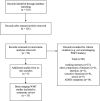Review of the Neural Processes of Working Memory Training: Controlling the Impulse to Throw the Baby Out With the Bathwater
- PMID: 33132926
- PMCID: PMC7511702
- DOI: 10.3389/fpsyt.2020.512761
Review of the Neural Processes of Working Memory Training: Controlling the Impulse to Throw the Baby Out With the Bathwater
Abstract
Background: Smartphone technology has enabled the creation of many working memory training (WMT) Apps, with those peer-reviewed described in a recent review. WMT claims to improve working memory, attention deficits, hyperactivity and fluid intelligence, in line with plasticity brain changes. Critics argue that WMT is unable to achieve "far-transfer"-the attainment of benefits to cognition from one taught context to another dissimilar context-associated with improved quality of life. However, brain changes after a course of WMT in frontoparietal and striatal circuits-that often occur prior to behavioral changes-may be a better indicator of far-transfer efficacy, especially to improve impulse control commonly dysregulated in those with addictive disorders, yet not commonly examined in WMT studies.
Method: In contrast to previous reviews, the aim here is to focus on the findings of brain imaging WMT training studies across various imaging modalities that use various paradigms, published via PubMed, Scopus, Medline, and Google Scholar.
Results: 35 brain imaging studies utilized fMRI, structural imaging (MRI, DTI), functional connectivity, EEG, transcranial direct current stimulation (tDCS), cerebral perfusion, and neurogenetic analyses with tasks based on visuospatial and auditory working memory, dual and standard n-back.
Discussion: Evidence suggests that repeated WMT reduces brain activation in frontoparietal and striatal networks reflective of increased neural circuitry efficiency via myelination and functional connectivity changes. Neural effects of WMT may persist months after training has ended, lead to non-trained task transfer, be strengthened by auxiliary methods such as tDCS and be related to COMT polymorphisms. WMT could be utilized as an effective, non-invasive intervention for working memory deficits to treat impulse and affective control problems in people with addictive disorders.
Keywords: CogMed; addiction; frontoparietal; n-back; neuroplasticity; striatal; working memory training.
Copyright © 2020 Brooks, Mackenzie-Phelan, Tully and Schiöth.
Similar articles
-
The effect of transcranial direct current stimulation combined with working memory training on working memory deficits in schizophrenic patients: study protocol for a randomized controlled trial.Trials. 2022 Sep 30;23(1):826. doi: 10.1186/s13063-022-06776-x. Trials. 2022. PMID: 36175919 Free PMC article.
-
The benefits of simultaneous tDCS and working memory training on transfer outcomes: A systematic review and meta-analysis.Brain Stimul. 2022 Nov-Dec;15(6):1541-1551. doi: 10.1016/j.brs.2022.11.008. Epub 2022 Nov 29. Brain Stimul. 2022. PMID: 36460294
-
Working memory training in children with borderline intellectual functioning and neuropsychiatric disorders: a triple-blind randomised controlled trial.J Intellect Disabil Res. 2022 Jan;66(1-2):178-194. doi: 10.1111/jir.12895. Epub 2021 Nov 10. J Intellect Disabil Res. 2022. PMID: 34755919 Free PMC article. Clinical Trial.
-
Intermittent theta burst stimulation (iTBS) combined with working memory training to improve cognitive function in schizophrenia: study protocol for a randomized controlled trial.Trials. 2020 Jul 29;21(1):683. doi: 10.1186/s13063-020-04563-0. Trials. 2020. PMID: 32727539 Free PMC article.
-
Substance use disorder and obesogenic eating: Does working memory training strengthen ability to abstain from unwanted behaviors? A systematic review.J Subst Abuse Treat. 2022 Jun;137:108689. doi: 10.1016/j.jsat.2021.108689. Epub 2021 Dec 13. J Subst Abuse Treat. 2022. PMID: 34952746
Cited by
-
The role of cognitive elements plays in physical activity interventions among individuals with attention-deficit/hyperactivity disorder: A systematic review of brain evidence.Brain Imaging Behav. 2025 Aug;19(4):949-963. doi: 10.1007/s11682-025-01027-4. Epub 2025 May 30. Brain Imaging Behav. 2025. PMID: 40442529 Review. No abstract available.
-
Understanding the roles of central and autonomic activity during sleep in the improvement of working memory and episodic memory.Proc Natl Acad Sci U S A. 2022 Nov;119(44):e2123417119. doi: 10.1073/pnas.2123417119. Epub 2022 Oct 24. Proc Natl Acad Sci U S A. 2022. PMID: 36279428 Free PMC article.
-
Individual differences in frontoparietal plasticity in humans.NPJ Sci Learn. 2022 Jun 23;7(1):14. doi: 10.1038/s41539-022-00130-1. NPJ Sci Learn. 2022. PMID: 35739201 Free PMC article.
-
Cognitive Training Effectiveness on Memory, Executive Functioning, and Processing Speed in Individuals With Substance Use Disorders: A Systematic Review.Front Psychol. 2021 Aug 13;12:730165. doi: 10.3389/fpsyg.2021.730165. eCollection 2021. Front Psychol. 2021. PMID: 34489833 Free PMC article.
-
A randomized controlled trial of computerized cognitive training to improve working memory in individuals with elevated repetitive negative thinking: Behavioral and neural outcomes.J Mood Anxiety Disord. 2024 Dec 2;9:100095. doi: 10.1016/j.xjmad.2024.100095. eCollection 2025 Mar. J Mood Anxiety Disord. 2024. PMID: 40655232 Free PMC article.
References
Publication types
LinkOut - more resources
Full Text Sources
Miscellaneous


